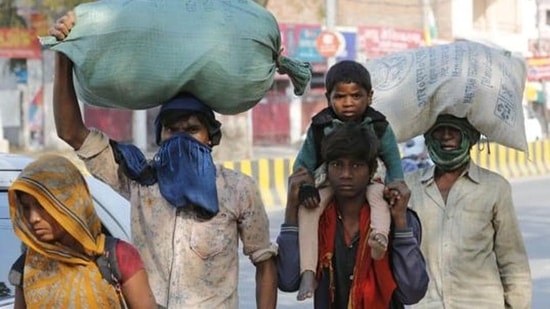A 4-chart cheat-sheet on India’s challenge of economic inequality
What is India’s basic economic inequality challenge?
What is India’s basic economic inequality challenge? Here are four charts which try and answer this question using data from the RBI’s KLEMS [capital (K), labour (L), energy (E), material (M) and services (S)] database, and the India Productivity Report prepared by the India KLEMS team, both of which were released on October 4.

There is no obvious big-bang idea to solve the inequality problem
Plotting employment and value-added shares of various industries – the KLEMS database uses 27 industry classifications – is the best way to make this point. Agriculture is the only obvious outlier on this count with an employment share of more than 40% and an income share of less than 15%. This is the source of the widely held opinion that India’s economic inequality can be solved by moving workers from farms to factories (manufacturing) and offices (services). The practicality of such a transition is more complicated . While some sectors, such as construction, trade and transport, and other services, seem to be doing alright on the income-employment balance question, the picture gets complicated when we take a broad-based look.
Delving deeper into the question shows inequalities within manufacturing and services
What the scatterplot does not show can be seen if one were to make a simple chart of relative income share – share in value-added divided by share in employment – for all 27 industries in the KLEMS database. Agriculture and allied activities have the lowest income share, as is to be expected. However, what is noteworthy is that relative income shares vary significantly across various kinds of manufacturing as well as services. This underlines the fact that just a farm to factory transition is not going to solve the inequality problem in India.
Industry-wise income inequality is only a part of the story
This is where the informality part comes into play. The India Productivity Report highlights how labour productivity – it is an important determinant of labour income – varies significantly between organised and unorganised-sector firms within the same industry. The report says that unorganised-sector firms had a two-thirds share in employment and one-third in real value added in total manufacturing in 2017-18. While this number highlights the inherent income inequality between the organised and unorganised sectors of the manufacturing economy, what is even more illuminating is that the labour productivity difference between the organised and unorganised sectors varies significantly across different manufacturing activities.
India has done well in labour productivity growth, but it is still a laggard among major economies
The report shows that India had the second highest growth (China tops the list) in labour productivity between 1981 and 2017. Despite its impressive growth performance, India continues to lag behind both developed and other BRICS economies. “Despite an almost sixfold increase between 1980 and 2017, India’s labour productivity in 2017 was only three-fourth of that of China, and Indonesia, and around one-half of Brazil and Thailand. Further, it was a mere 20% of that in Japan and 13% of that in US. However, a comparison of India’s labour productivity and of other selected countries with that of China (China equal to one) reveals (Figure 6.13) that while China had almost the lowest level of labour productivity (almost equal to India) in 1980, India’s labour productivity in 2017 is only 75% of China’s”, the report says.
“If India wishes to emulate China and achieve the same economic might, then it also must narrow down the relative gap in labour productivity by adopting suitable policies to increase its labour productivity at a faster pace— not only to improve its economic growth but also the per capita income of its population”, the report adds.
Get Current Updates on India News, Lok Sabha Election 2024 live, Infosys Q4 Results Live, Elections 2024, Election 2024 Date along with Latest News and Top Headlines from India and around the world.









